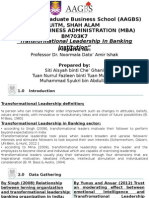The Thematic Apperception Test (Tat) and Mcclelland'S Achievement Motivation Theory
The Thematic Apperception Test (Tat) and Mcclelland'S Achievement Motivation Theory
Uploaded by
Emilia Ahmad Zam ZamCopyright:
Available Formats
The Thematic Apperception Test (Tat) and Mcclelland'S Achievement Motivation Theory
The Thematic Apperception Test (Tat) and Mcclelland'S Achievement Motivation Theory
Uploaded by
Emilia Ahmad Zam ZamOriginal Description:
Original Title
Copyright
Available Formats
Share this document
Did you find this document useful?
Is this content inappropriate?
Copyright:
Available Formats
The Thematic Apperception Test (Tat) and Mcclelland'S Achievement Motivation Theory
The Thematic Apperception Test (Tat) and Mcclelland'S Achievement Motivation Theory
Uploaded by
Emilia Ahmad Zam ZamCopyright:
Available Formats
The Thematic
Apperception
Test (TAT)
and
McClelland's
Achievement
Motivation
Theory
Criticizing
economics as
being an overly
simplistic, and
rationalistic
discipline,
David
McClelland
points out that
it does not
really account
for how humans
actually behave.
For example,
Elton Mayo and
his work at the
Hawthorne
Western
Electric plant in
the 1920s and
30s recognized
the non-
economic
motivations of
workers.
In the
Hawthorne
Studies... the
importance of
the peer group
was recognized
in determining
employee
motivation.
Motivation research has long considered human motives and needs.
However, isolating people's motivational needs can be a difficult
process because most people are not explicitly aware of what their
motives are.
In attempting to understand employee motivation, Abraham Maslow
proposed a hierarchy of needs. David McClelland furthered this idea
in his learned needs theory. McClelland's experimental work
identified sets of motivators present to varying degrees in different
people. He proposed that these needs were socially acquired or
learned. That is, the extent to which these motivators are present
varies from person to person, and depends on the individual and his or
her background.
McClelland's experiment -- the Thematic Apperception Test (TAT) --
consisted of showing individuals a series of pictures and asking them
to give brief descriptions of what was happening in the pictures. The
responses were analyzed in terms of the presence or absence of
certain themes. The themes McClelland and his associates were
looking for revolved around the following motivators: achievement,
affiliation and power.
According to David McClelland, regardless of culture or gender,
people are driven by three motives:
achievement,
affiliation, and
influence.
Since McClelland's first experiments, over 1,000 studies relevant to
achievement motivation have been conducted. These studies strongly
support the theory.
. Achievement (nAch)
. The need for achievement is characterized by the wish to take
responsibility for finding solutions to problems, master complex
tasks, set goals, get feedback on level of success.
. Affiliation (nAff)
.
The need for affiliation is characterized by a desire to belong, an
enjoyment of teamwork, a concern about interpersonal relationships,
and a need reduce uncertainty.
. Power (nP)
.
The need for power is characterized by a drive to control and
influence others, a need to win arguments, a need to persuade and
prevail.
.
According to McClelland, the presence of these motives or drives in
an individual indicates a predisposition to behave in certain ways.
Therefore, from a manager's perspective, recognizing which need is
dominant in any particular individual affects the way in which that
person can be motivated.
.
UNDERSTANDING MOTIVES -- So, what does all this
mean?
. High achievement motivation
People driven
by the
achievement
motive like to
test themselves
against their
environment
and attain
standards of
excellence.
In areas of
management
where high
levels of
delegation may
be required,
high
achievement
motivated
individuals may
be unable to
Specifically, achievement motivation is defined as a non-conscious
concern for achieving excellence through individual efforts. Such
individuals set challenging goals for themselves, assume personal
responsibility for goal accomplishment, are highly persistent in the
pursuit of these goals, take calculated risks to achieve the goals, and
actively collect and use information for purposes of feedback.
High achievement motivated managers are also strongly inclined to be
personally involved in performing their organizational tasks. However,
they may also be reluctant to delegate authority and responsibility.
Thus, high achievement motivation may be expected to result in poor
performance of high- level executives in large organizations.
High achievement motivation is predicted to contribute to effective
entrepreneurship and effective leadership of small task-oriented
groups.
Achievement motivation is positively related to the leadership of
give up their
personal
involvement
with the task.
small task-oriented groups and small entrepreneurial firms and
negatively related to the effectiveness of high- level managers in
complex organizations or in political situations.
. High power motivation
People
motivated by
power are
concerned
about their
impact on other
people--
convincing
someone of
their point of
view or
empowering
others around
them, and
finding ways to
connect with
and influence
powerful
people.
Power
motivation is
assumed to be
predictive of
leader
effectiveness.
...the power
motive is
necessary for
leaders to be
effective
because it
induces them to
engage in social
influence
behavior
Power motivation is defined as the concern for acquiring status and
having an impact on others. McClelland used power motivation as a
measure of social influence behaviors. Clearly, since most
management activities require the use of social influence behaviors
and since power motivation measures an individual's desire to
influence, the power motive is important for leadership
effectiveness.
David McClelland proposed the Leader Motive Profile Theory (LMP
theory) in which he argued that a high power motivation, greater than
the affiliation motive, is predictive of leader effectiveness.
Highly power-motivated individuals obtain great satisfaction from the
exercise of influence. Consequently, their interest in the exercise of
leadership is sustained.
High power motivation is predicted to result in effective managerial
performance in middle and high-level positions. However, unless
constrained in some manner, some power-motivated managers may
also be predicted to exercise power in an aggressive manner for self-
aggrandizing purposes, to the detriment of their organizations.
. High affiliation motivation
People driven
by the affiliation
motive are
concerned
about the
Affiliative motivation is defined as a nonconscious concern for
establishing, maintaining, and restoring close personal relationships
with others. Individuals with high affiliative motivation tend to be
non-assertive, submissive, and dependent on others.
quality of their
relationships.
They enter into
relationships
for the sake of
the
relationships--
not for gain or
influence. They
are concerned
with how
harmonious and
reliable their
relationships
are and are
likely to be
upset when
disruptions to
relationships
occur.
Such managers are expected to manage on the basis of personal
relationships with subordinates. This may result in them showing
favoritism toward some.
As managers, highly affiliative individuals are predicted to be
reluctant to monitor the behavior of subordinates, give negative
feedback to others, or discipline their subordinates. However, when
the power motive is higher than the affiliative motive, individuals are
disinclined to engage in dysfunctional management behaviors such as
submissiveness, reluctance to monitor and
discipline subordinates, and favoritism.
. Need for Achievement and Entrepreneurship
.
Originally, the need for achievement was the greatest concern for
McClelland. He was particularly interested in this need and associated
behaviors because most organizations want their employees to
achieve. The 'need achievement' refers to an unconscious disposition
to energize and drive. High nAch individuals are constantly
'competing with standards of excellence'. Further, they are
attracted to tasks of moderate difficulty.
McClelland further described the profile of an entrepreneur as
someone high in nAch (Achievement) and low in nP (Power), while good
managers have high nPower and low nAch.
Over four decades of research into the characteristics of
entrepreneurs has established that the essential need for
achievement for entrepreneurship is learned at an early age. Persons
with a high 'need achievement' have a general predisposition towards
entrepreneurial activity.
. Summary
.
Adults are assumed to possess all three motivations to one degree or
another, however, one of the motives is usually dominant. Managers
need to identify what motivates others and to create appropriately
motivating conditions for them.
People with achievement motives are motivated by standards of
excellence, delineated roles and responsibilities and concrete, timely
feedback. Those with affiliation motives are motivated when they can
accomplish things with people they know and trust. And the power
motive is activated when people are allowed to have an impact,
impress those in power, or beat competitors.
You might also like
- Ben Franklin's 12 Rules of ManagementDocument7 pagesBen Franklin's 12 Rules of Managementpeytonc.huckabeeNo ratings yet
- Work Motivation ScaleDocument6 pagesWork Motivation ScaleScribdTranslations80% (5)
- Assigngment of LeadershipDocument4 pagesAssigngment of LeadershipTariq Jeph100% (1)
- Conflict ManagementDocument5 pagesConflict ManagementRowell SorianoNo ratings yet
- David Jackson Article Head Heart Guts Anatomy of A Whole LeaderDocument12 pagesDavid Jackson Article Head Heart Guts Anatomy of A Whole LeaderSunita Bhanu PrakashNo ratings yet
- Kouzes and Posner's Five Practices of Exemplary LeadershipDocument1 pageKouzes and Posner's Five Practices of Exemplary LeadershipCraig D'SouzaNo ratings yet
- Chapter 9 Leadership and Decision Making: Business Essentials, 12e (Ebert/Griffin)Document32 pagesChapter 9 Leadership and Decision Making: Business Essentials, 12e (Ebert/Griffin)distearsNo ratings yet
- 2 Legal LiabilityDocument68 pages2 Legal LiabilityEmilia Ahmad Zam ZamNo ratings yet
- Achievement MotivationDocument2 pagesAchievement MotivationApurwa GohilNo ratings yet
- What Is QualityDocument3 pagesWhat Is Qualitysubhash kumar1958100% (2)
- ISO9001 2015 Frequently Asked QuestionsDocument5 pagesISO9001 2015 Frequently Asked QuestionsJyoti Jeevan SharmaNo ratings yet
- Healthy Work: Managing Stress in The Workplace: Health and Safety Is Good BusinessDocument22 pagesHealthy Work: Managing Stress in The Workplace: Health and Safety Is Good BusinessSanthoshi PriyaNo ratings yet
- Organisation Development 4Document12 pagesOrganisation Development 4Su_NeilNo ratings yet
- Grossman-Why Models MatterDocument10 pagesGrossman-Why Models Matteranon_935023017No ratings yet
- Critiques On Mission and Vision G1 Team InutilDocument5 pagesCritiques On Mission and Vision G1 Team InutilBena Borrero100% (1)
- Organizational Behavior - Our Inherent Power of Generalization Helps Us To Predict TheDocument19 pagesOrganizational Behavior - Our Inherent Power of Generalization Helps Us To Predict TheJay Mark EscondeNo ratings yet
- Working With Team DynamicsDocument4 pagesWorking With Team DynamicsNoshaba KhanNo ratings yet
- MGT 3013 Questions Ch10Document51 pagesMGT 3013 Questions Ch10skamaleoNo ratings yet
- Understanding The New International Standard For OH&SDocument12 pagesUnderstanding The New International Standard For OH&SNarasimharaghavanPuliyurKrishnaswamyNo ratings yet
- ISO 9001 Auditing Practices GroupDocument31 pagesISO 9001 Auditing Practices GroupphucakjNo ratings yet
- KP Model 2013Document36 pagesKP Model 2013rozitazinNo ratings yet
- JSBM 12086Document21 pagesJSBM 12086VarunNo ratings yet
- Understanding HR Management in The Context of Organizations and The IDocument29 pagesUnderstanding HR Management in The Context of Organizations and The InospmisdeNo ratings yet
- Strategy Structure Systems Style Staff Skills Shared Values/ Superordinate GoalsDocument6 pagesStrategy Structure Systems Style Staff Skills Shared Values/ Superordinate Goalskdatta86No ratings yet
- Workplace Stress: A Guide For Employers and WorkersDocument16 pagesWorkplace Stress: A Guide For Employers and WorkersAssem SalahNo ratings yet
- Managing Quality 2Document3 pagesManaging Quality 2oteghele peterNo ratings yet
- Notes On Leadership - Aug 2018Document8 pagesNotes On Leadership - Aug 2018baharazadiNo ratings yet
- A Review of Action Learning LiteratureDocument7 pagesA Review of Action Learning LiteratureMaryreneeNo ratings yet
- Lee Iococca - An AutobiographyDocument25 pagesLee Iococca - An AutobiographyAbhishek SainiNo ratings yet
- Amway Business Reference GuideDocument76 pagesAmway Business Reference GuidedzugeekNo ratings yet
- Runde-Flanigan Model of Conflict ManagementDocument1 pageRunde-Flanigan Model of Conflict ManagementSraddha PatelNo ratings yet
- Transformational Leadership Theory - Meaning, Criticisms and Its ImplicationsDocument1 pageTransformational Leadership Theory - Meaning, Criticisms and Its ImplicationsSatyam SachanNo ratings yet
- Commitment vs. Compliance: Ten Reasons Why You Need Your Workers' Hearts, Not Just Their HandsDocument6 pagesCommitment vs. Compliance: Ten Reasons Why You Need Your Workers' Hearts, Not Just Their HandsMac McIntireNo ratings yet
- Edgar CompletedDocument15 pagesEdgar CompletedAh BiiNo ratings yet
- Total Quality Management: Pakistan International AirlinesDocument6 pagesTotal Quality Management: Pakistan International AirlineshamidjavaidNo ratings yet
- Hawthorne StudiesDocument29 pagesHawthorne StudiesaksmloreNo ratings yet
- F - 15503 ISo 17021 2011Document33 pagesF - 15503 ISo 17021 2011Julio Cesar Valle ValdezNo ratings yet
- What Is The EFQM Excellence Model and How Useful Is It For YouDocument6 pagesWhat Is The EFQM Excellence Model and How Useful Is It For Youcrystal monteiroNo ratings yet
- Group Behaviour and Team WorkDocument74 pagesGroup Behaviour and Team Worksujit100% (1)
- CH 01Document33 pagesCH 01Kshitij vijayNo ratings yet
- OD Applications:: Application of OD in Business EnterprisesDocument4 pagesOD Applications:: Application of OD in Business EnterprisesJitendra KumarNo ratings yet
- Training and DevelopmentDocument5 pagesTraining and DevelopmentAlif AnasNo ratings yet
- Quality (Business) : DescriptionDocument11 pagesQuality (Business) : DescriptionAsma HussainNo ratings yet
- Managing Quality and Developing PerformanceDocument25 pagesManaging Quality and Developing PerformancemiffypangNo ratings yet
- Accountability and Responsibility in Corporate GovernanceDocument64 pagesAccountability and Responsibility in Corporate GovernanceNeha VermaNo ratings yet
- Principles of Management BTechDocument41 pagesPrinciples of Management BTechAman SinhaNo ratings yet
- Solving Problems and Conflicts in A TeamDocument30 pagesSolving Problems and Conflicts in A TeamAnurag SinghNo ratings yet
- Assignment Business Communication Skills (Mba I ST Semester) (Section A)Document14 pagesAssignment Business Communication Skills (Mba I ST Semester) (Section A)Karan HansNo ratings yet
- Likert's Management SystemDocument1 pageLikert's Management SystemMalay EbajoNo ratings yet
- Literature ReviewDocument41 pagesLiterature ReviewMunguongeyo Ivan100% (1)
- HRM CH 8Document60 pagesHRM CH 8karim kobeissiNo ratings yet
- Empowering LeadershipDocument3 pagesEmpowering LeadershipIkram El Bacha100% (1)
- The Effect of Authentic Transformational Leadership On Follower and Group Ethics PDFDocument17 pagesThe Effect of Authentic Transformational Leadership On Follower and Group Ethics PDFHarry H GaiyaNo ratings yet
- Directing: Mae Belle G. Lacson, RNDocument26 pagesDirecting: Mae Belle G. Lacson, RNBelle Lacson ÜNo ratings yet
- SM Strategy ExecutionDocument64 pagesSM Strategy ExecutionMaulik BuddhdevNo ratings yet
- Traditional Mentoring: Potential LimitationsDocument5 pagesTraditional Mentoring: Potential Limitations1koucNo ratings yet
- Transformational Leadership - 6385 - GRP 7Document8 pagesTransformational Leadership - 6385 - GRP 7Palize QaziNo ratings yet
- Transformational LeadershipDocument8 pagesTransformational LeadershipArdana RaffaliNo ratings yet
- Quality: a Total Management Concept: A Philosophical ApproachFrom EverandQuality: a Total Management Concept: A Philosophical ApproachNo ratings yet
- The Complete CEO: The Executive's Guide to Consistent Peak PerformanceFrom EverandThe Complete CEO: The Executive's Guide to Consistent Peak PerformanceNo ratings yet
- AUD610Document4 pagesAUD610Emilia Ahmad Zam ZamNo ratings yet
- Far600-Poh Kong Vs ShellDocument15 pagesFar600-Poh Kong Vs ShellEmilia Ahmad Zam ZamNo ratings yet
- Target CostingDocument22 pagesTarget CostingEmilia Ahmad Zam ZamNo ratings yet
- 3 PomDocument45 pages3 PomjennetNo ratings yet
- Motivating Employees at Proctor and GambleDocument53 pagesMotivating Employees at Proctor and Gamblebmumtaz100% (3)
- Red Bull Wingfinder - EBMCDocument14 pagesRed Bull Wingfinder - EBMCNaidaNo ratings yet
- Summative Test Organization and ManagementDocument5 pagesSummative Test Organization and ManagementalexNo ratings yet
- Organizational Behaviour - An IntroductionDocument4 pagesOrganizational Behaviour - An IntroductionGirish TripathyNo ratings yet
- Group 9Document16 pagesGroup 9Yelly HazeNo ratings yet
- Teaching PowerPoint Slides - Chapter 4Document14 pagesTeaching PowerPoint Slides - Chapter 4Syahirah SyeirahNo ratings yet
- Induction and Orientation Lect 5Document28 pagesInduction and Orientation Lect 5imadNo ratings yet
- MAN2120 Module 1 Introduction To OBDocument7 pagesMAN2120 Module 1 Introduction To OBSadat Sadman SaadNo ratings yet
- A Three-Component Conceptualization of Organizational CommitmentDocument8 pagesA Three-Component Conceptualization of Organizational CommitmenthudaNo ratings yet
- HRMS Course ContentDocument1 pageHRMS Course ContentsekharbynaNo ratings yet
- Trends Report 2024 1.1Document53 pagesTrends Report 2024 1.1widhie soekarnenNo ratings yet
- Absensi Jobstreet Event - Semarang 19 Dec 2023 (1-114)Document15 pagesAbsensi Jobstreet Event - Semarang 19 Dec 2023 (1-114)ono projoNo ratings yet
- Making Things Happen A Model of Proactive MotivatiDocument31 pagesMaking Things Happen A Model of Proactive MotivatiDanielNo ratings yet
- HRM Notes12Document61 pagesHRM Notes12Priyesh SolkarNo ratings yet
- Business Journals Leadership Trust Blog: What Motivates Employees From Different GenerationsDocument3 pagesBusiness Journals Leadership Trust Blog: What Motivates Employees From Different GenerationsJullianna RemiendoNo ratings yet
- Introduction To Management Chaper 6Document14 pagesIntroduction To Management Chaper 6sampkanbessaNo ratings yet
- Human Resource Management PresentationDocument12 pagesHuman Resource Management PresentationM.No ratings yet
- 15five S Performance Review PlaybookDocument27 pages15five S Performance Review PlaybookblejapregolemaNo ratings yet
- Organizational Behavior: An Introduction: Dr. Saswat BarpandaDocument30 pagesOrganizational Behavior: An Introduction: Dr. Saswat BarpandaGaurav SinghNo ratings yet
- Audit Itinerary and Checklist - StatusDocument28 pagesAudit Itinerary and Checklist - StatusMaria Cristina CoNo ratings yet
- MGMT 3000 SyllabusDocument7 pagesMGMT 3000 Syllabusajc812No ratings yet
- Thrust Areas in Human Resource Development - FinalDocument16 pagesThrust Areas in Human Resource Development - FinalShashank BijjhalliNo ratings yet
- Test Bank For Human Resource Management 15th Edition MathisDocument18 pagesTest Bank For Human Resource Management 15th Edition Mathisdatmessie9qew2No ratings yet
- Personnel ManagementDocument19 pagesPersonnel ManagementYusairah DarapaNo ratings yet
- Ronaldo's Mindset 7 Lessons To Become EliteDocument6 pagesRonaldo's Mindset 7 Lessons To Become Elitenitishstudy05No ratings yet
- Aytenew Abebe Proposal AssignmentDocument15 pagesAytenew Abebe Proposal AssignmentAytenewNo ratings yet
- Tiếng Anh Trong Kinh Doanh Quốc Tế: Chapter 3: Work And MotivationDocument12 pagesTiếng Anh Trong Kinh Doanh Quốc Tế: Chapter 3: Work And MotivationhoàiNo ratings yet
- 2024 Trading Roadmap by TradeZellaDocument5 pages2024 Trading Roadmap by TradeZellaprincenagar3337No ratings yet





























































































